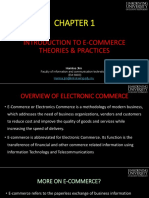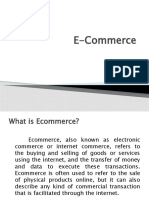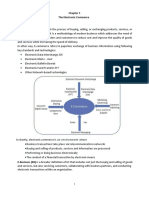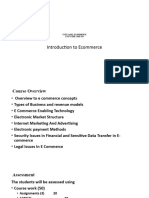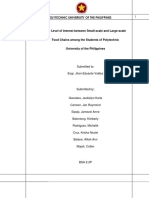UNIT- 1
E- COMMERCE AND ITS TECHNOLOGICAL ASPECTS
Meaning of E-Commerce: E-Commerce involves activities, such as delivery of information,
products, services and payment through the electronic medium. It involves buying and selling of
products and services through the internet.
Definition of E- Commerce: E- Commerce is defined as a business activity which uses an electronic
medium for buying or selling of goods and services.
Scope in E-Commerce:
1. Exchange of digitized information: It refers to communication between two parties or
transmission of electronic orders. These exchanges can be between organisations or
individuals.
2. Technology-enabled: E-Commerce is all about technology-enabled transactions. Web
browsers and other interfaces including Automated Teller Machines (ATMs) also fall in the
category of e-commerce.
3. Customer Retention: E-Commerce helps in retaining customers through fast order fulfilment
and effective Customer Relationship Management (CRM).
4. Accounting: Financial Accounting, Treasury Management and Asset Management are best
possible in e-commerce because of integrated database.
FEATURES OF E-COMMERCE:
Non-Cash Transactions: E-Commerce enables the use of credit cards, debit cards,
smart cards, electronic fund transfer via bank's website, and other modes of
electronics payment.
24x7 Service availability: E-commerce automates the business of enterprises and
the way they provide services to their customers. It is available anytime, anywhere.
Digital Marketing: E-commerce increases the reach of advertising of products and
services of businesses. It helps in better marketing management of
products/services.
Improved Sales: Using e-commerce, orders for the products can be generated
anytime, anywhere without any human intervention. It gives a big boost to existing
sales volumes.
Inventory Management: E-commerce automates inventory management. Reports
get generated instantly when required. Product inventory management becomes
very efficient and easy to maintain.
Customer Support and Service: E-commerce businesses provide customer support
and service through digital channels such as email and helpdesk to resolve issues.
1
�E- MARKET: It involves the use of electronic technologies or platforms to sell the
products. It includes phone calls, texts, emails, websites and apps. Ex: Amazon,
Flipkart, e-bay.
E-MARKETING: It refers to those strategies and methods which utilize online ways to
reach the target and potential customers. E-Marketing is also known as online or
internet advertising.
Advantages of E-Marketing:
1. Fast Response: The response rate of internet marketing is fast. For example,
uploading something, and it goes viral. Then it would reach millions of people
overnight.
2. Cost efficient: Compared to the other media of advertising, it is more reasonable.
3. Greater exposure to your product: Going viral with one post can provide greater
exposure to your product or service.
4. Accessibility: The beauty of the online world and e-marketing is that its available
from everywhere all over the world.
Disadvantages of E-Marketing:
1. Technology dependent: E-Marketing is entirely dependent on technology and the
internet, a slight disconnection in service can cause major delay in the activities of
business.
2. Worldwide competition: When you launch your product online, you face global
competition because its available everywhere.
3. Privacy and Security Issues: Privacy and security issues are very high because
your information is open to everyone, therefore one has to be very careful about
what goes online.
4. Maintenance Cost: With the fast changing technological environment, you have to
grow consistently with the speed of technology, and the maintenance cost is very
high.
TYPES OF E-MARKETING:
1. E-Mail Marketing: Sending emails about your product or service to your exact
targeted market is not only affordable but also very effective.
2. Social Media Marketing: It could be done on any social media platform such as
Facebook, Instagram, Whatsapp and Youtube.
3. Video Marketing: You can acquire the attention and emotions of your target
market by showing them a video clip about your product or service.
4. Affiliate Marketing: Affiliate marketing is promoting some products of specific
brands and earning your commission from every sale.
2
�E-COMMERCE BUSINESS MODELS
E-commerce business models can generally be categorized into the following categories.
Business-to-Business (B2B)
Business-to-Consumer(B2C)
Consumer-to -Consumer (C2C)
Consumer-to-Business(C2B)
Business-to-Government (B2G)
Government -to-Citizen(G2C)
Business-to-Business (B2B):
B2B e-commerce involves transactions between businesses, where one business sells
products or services to another business. Examples include manufacturers selling raw
materials to wholesalers, distributors selling products to retailers.
Business-to-Consumer (B2C):
In B2C E-Commerce, businesses sell products or services directly to consumers through
online websites or digital marketplaces. Examples include online retailers such as
Amazon, Walmart.com and Apple Store , where consumers can purchase a wide range
of products.
Consumer-to-Consumer (C2C):
C2C e-commerce enables individual consumers to buy and sell products or services to
each other through online platforms. Examples include online auction sites like eBay.
Consumer-to-Business (C2B):
C2B e-commerce occurs when individual consumers sell products or services to
businesses or offer their skills, expertise, or creative work to businesses. Examples
include freelance platforms like Upwork, where individuals offer services such as
graphic design, writing, programming and consulting to businesses on a project basis.
Business-to-Government (B2G):
B2G involves transactions between businesses and government agencies or
organizations, where businesses sell products or services to government entities.
Examples include businesses supplying goods or services to government agencies, such
as defense contracts or infrastructure projects.
Government-to-Citizen (G2C):
G2C e-commerce refers to transactions between government agencies or organizations
and individual citizens, where governments provide services or information to citizens
through online platforms. Examples include government websites for paying taxes,
renewing licenses or applying for permits.
3
�ELECTRONIC DATA INTERCHANGE (EDI)
EDI stands for Electronic Data Interchange. EDI is an electronic way of transferring
business documents in an organization internally, between its various departments or
externally with suppliers, customers, or any subsidiaries. In EDI, paper documents are
replaced with electronic documents such as word documents, spreadsheets, etc.
EDI DOCUMENTS:
Following are the few important documents used in EDI
Invoices
Purchase orders
Shipping Requests
Acknowledgement
Business Correspondence letters
ADVANTAGES OF AN EDI SYSTEM:
Reduction in data entry errors: Chances of errors are much less while using a
computer for data entry.
Shorter processing life cycle: Orders can be processed as soon as they are entered
into the system. It reduces the processing time of the transfer documents.
Electronic form of data: It is quite easy to transfer or share the data, as it is present
in electronic format.
Reduction in paperwork: As a lot of paper documents are replaced with electronic
documents, there is a huge reduction in paperwork.
Cost Effective: As time is saved and orders are processed very effectively, EDI
proves to be highly cost effective.
ADVANTAGES OF E-COMMERCE:
Advantages to Organizations
Advantages to Consumers
Advantages to Society
ADVANTAGES OF E-COMMERCE TO ORGANIZATIONS
Using e-commerce, organizations can expand their market to national and
international markets with minimum capital investment.
E-commerce helps organizations to reduce the cost to create process, distribute,
retrieve and manage the paper based information by digitizing the information.
E-commerce improves the brand image of the company.
E-commerce helps organization to provide better customer services.
E-commerce simplifies the business processes and makes them faster and efficient.
E-commerce reduces the paper work.
4
�ADVANTAGES OF E-COMMERCE TO CONSUMERS
It provides 24x7 support. Customers can enquire about a product or service and
place orders anytime, anywhere from any location.
E-commerce application provides users with more options and quicker delivery of
products.
E-commerce application provides users with more options to compare and select the
cheaper and better options.
A customer can put review comments about a product and can see what others are
buying, or see the review comments of other customers before making a final
purchase.
It provides readily available information. A customer can see the relevant detailed
information within seconds, rather than waiting for days or weeks.
E-Commerce increases the competition among organizations and as a result,
organizations provide substantial discounts to customers.
ADVANTAGES OF E-COMMERCE TO SOCIETY
Customers need not travel to buy a product thus less traffic on road and low air
pollution.
E-commerce helps in reducing the cost of products, so less affluent people can also
afford the products.
E-commerce has enabled rural areas to access services and products which are
otherwise not available to them.
E-commerce helps the government to deliver public services such as healthcare,
education, social services at a reduced cost and in an improved manner.
DISADVANTAGES OF E-COMMERCE:
Disadvantages to Organizations
Disadvantages to Consumers
Disadvantages to Society
DISADVANTAGES OF E-COMMERCE TO ORGANISATIONS:
• Update hardware and software regularly.
• Website maintenance at a periodic interval
• Security and credit card issues.
• Fraudulent orders
• Expensive internet services.
5
�DISADVANTAGES OF E-COMMERCE TO CONSUMERS:
• Unable to personally examine the products.
• Privacy and security in online purchases
• Delays in receiving products
• Lack of personal interaction
• Website fraud
DISADVANTAGES OF E-COMMERCE TO SOCIETY:
• Digital divide
• Job Displacement
• Loss for local businesses
• Environmental impact.
• Data Privacy Concerns.
• Counterfeit and Pirated Goods.
STEPS IN E-COMMERCE:
1. Online Store Visit
2. Product or Service Selection
3. Product Information and Reviews
4. Adding to Cart
5. Placing an order
6. Payment Method Selection
7. Payment Authorization and Processing
8. Order Confirmation
9. Order Fulfillment and Shipping
10. Delivery of Product
11. Customer Support and After-Sales Services.
E-COMMERCE ARCHITECTURE:
E-Commerce architecture is a framework of an online e-commerce platform with all the design
and other technical details and components that help to sell and buy goods.
The architecture model in ecommerce is the way all the technical components and structures
are organized to provide the needed layers, subsystems, and components of an ecommerce
platform and interact between them.
Two-tier Architecture: It is an architecture where the client (interface layer) communicates
directly with the e-commerce platform’s data layer. This architecture can become limiting as
the business grows. It makes it challenging to add new functionality or scale to the system.
6
� Three-tier Architecture: The three layers of e-commerce architecture are as follows:
a) Presentation layer: This user-facing layer includes the website, layout, user
interface, personal account portal, and any other part of the system end users can
reach.
b) Application layer: An application layer usually handles the business logic and all
the internal processes, including product catalog management, shopping carts,
payment processing systems, and order tools that make the system work.
c) Data layer: At this tier, all the data related to the ecommerce platform is stored. It
includes product information, customer data, order history, and many other details
the system may need.
COMPONENTS OF E-COMMERCE TECHNICAL ARCHITECTURE FOR
MODERN SOLUTIONS:
1. Presentation layer: You can find all the applications needed for an ecommerce
system functioning at this tier: website, mobile applications, personal accounts,
gadget interfaces, and other front-end client apps. This tier doesn’t feature any
business logic and doesn’t show any unnecessary data
2. Business logic layer: This level contains business logic as several separate blocks
related to different industries. Each block works with requests from the application
layer, controls commerce modules, organizes data and integrations.
3. Commerce modules layer: Every module is a separate block of features and
capabilities that work for one particular goal: catalog module, pricing module,
marketing module, inventory and more.
4. Best-in-breed applications layer: This includes databases (similar to the Data
layer in an old-fashioned map, but wider), search modules, storages, cache, MySql
tools etc. The main part of the system (ecommerce) is connected to this tier via API
as well, which means any of the modules (or “Atoms”) can be easily replaced or
exchanged.
5. 3rd –party apps layer: This level is the last, though it plays the same role for
customers as a presentation layer. It uses API to connect the whole system to the
user-visible interfaces, but this time these are not the apps created by a system, but
3rd-party apps connected to the ecommerce platform and necessary for its
functioning. This includes CRMs, ERP systems, any payment systems.
TYPES OF E-COMMERCE ARCHITECTURE
1. Monolithic Architecture
2. SaaS Solutions
3. MACH Architecture
1. Monolithic Architecture: Monolithic architecture is a standard approach where all
components of a webstore are interconnected, causing any back-end modifications
to impact the entire solution. As a result, rebuilding the entire ecommerce system
becomes the only way to implement any small changes.
7
� Advantages of Monolithic Architecture:
a) They are simple and easy to use: The monolithic architecture is generally
straightforward to develop, test, and deploy because it is all contained within one
codebase and can be deployed as a single package.
Disadvantages of Monolithic Architecture:
a) Not Scalable and Expensive: Monolithic architecture can be difficult to scale
because all components are interdependent. The only way to scale it is to upgrade
the whole system. Scaling it takes time and resources. If you do this open, the
expenditure will be extra high.
b) Difficult to maintain: The changes made to one component can have unintended
consequences in other parts of the application. This is why the maintenance is
usually difficult.
c) Rigid and not technology-friendly: All components of the monolithic solution
must use the same technology stack. If you are planning to try something new,
choosing a monolithic solution is a bad idea.
2. SaaS Solutions: These are cloud-based solutions that can offer microservices.
However, SaaS solutions are fully closed: licensed through subscriptions and fully
controlled by providers, they require provider’s confirmation for any changes.
Smaller businesses with slow growth and basic feature needs can potentially benefit
from these systems, however, it is still not the perfect option to choose.
Advantages of SaaS Solutions:
a) Ready-to-go: Once you install a SaaS solution, you can use it right away. It is
usually packed with all the needed features out-of-the-box, and already set up.
b) Automatic updates: You do not need any resources for maintenance and
updates. The provider is responsible for all the technical parts. The bad side is
that it cannot adapt to your needs.
Disadvantages of SaaS Solutions:
a) Provider-dependent: To maintain the software and ensure its availability, you
need to rely on a provider. In case the provider fails to upgrade some part or
takes too long to change anything, you cannot change the situation, and have to
wait.
b) Security concerns: As SaaS solutions are usually based on the web, you have to
thoroughly check if the vendor offers a good enough level of security.
c) Integration challenges: SaaS solutions can only integrate to the tools they are
initially built for. Integration with any other tools can become a real challenge.
3. MACH Architecture: MACH means Microservices, API-first, Cloud-native and
Headless. This kind of ecommerce system is the best one for building a strong and
future-proof ecommerce businesses with fast time-to-value.
Advantages:
a) Accessibility: Micro services, headless and open-source architecture based on
Atomic principles is publicly available and can be freely used, modified, and
distributed.
b) Flexibility: Modular architecture allows for easy customization and integration
with other systems and software, making it a flexible option for businesses.
8
� c) Cost-effective: Modern solutions like Virto are often order-based or GMV-
based with transparent pricing principles. Instead of spending loads of money
for each upgrade and having many features you never use, you can buy the set of
features you really need and pay for them and your innovations only.
d) Easy integrations: API-based systems can connect to basically everything.
Once you need to use any 3rd-party system, just interconnect it with your
existing assets, and it will work.
Disadvantages:
a) The complexity of the architecture: Modern ecommerce systems bring many
opportunities for your business development and growth, however, you need to
make sure that your technical team will be able to bring the needed innovations.
b) No ready-to-use front end: As headless solutions have a separate front end and
back end, they often cannot provide a ready-to-go website with standard
features.
WEB BASED E-COMMERCE ARCHITECTURE:
Web based e-commerce architecture is basically the same as any other e-commerce platform
architecture. The idea is that such architecture is closely bonded with the web interface of the
ecommerce website and can be split into two basic layers — client-side (front end) and
server-side (back-end).
To build a website architecture, you need to create a structure that makes it easy for users to
navigate, find products, and make purchases. Here are some steps to follow:
1. Define the goals of e-commerce website. What you want to achieve with the site and
what you will be offering?
2. Build a sitemap and the structure of website pages. Website hierarchy will help in
managing pages and tracking how users navigate through them.
3. Think about the homepage. Design it to grab the customers' attention and encourage
them to explore the platform.
4. Create product categories and pages. For each category, create a separate space where
customers can find all the relevant info .
5. Design the shopping cart and organize the checkout process to make the process
simple and straight forward.
6. Take care of mobile users. Make your website mobile-responsive. More and more
users are shopping on their mobile devices. Make sure your ecommerce website
adapts to different screen sizes and devices.
9
�10
















